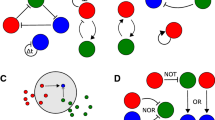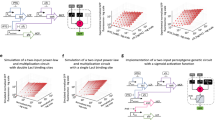Abstract
There exist two classical paradigms in computation: the symbolic representation and the connectionist approximation. In addition to these two conventional paradigms, there are other, newer, approaches that are not so well established, but belonging to the brainstorming frontier between science and engineering. These new approaches include Bioware computation that proposes using real biological systems as computing elements. In this paper biological computing paradigms are studied by the programming capabilities of cellular cultures, mostly neural cultures, grown over multielectrode arrays with bi-directional communications. The systems are able of reading the cellular network activity and act over the network by stimulating the cells in different locations and with different approaches for superimposing a desired behaviour over the cultures.







Similar content being viewed by others
References
Ammermuller J, Kolb H (1995) The organization of the turtle inner retina. I. ON- and OFF-center pathways. J Comp Neurol 358(1):1–34
Ammermuller J, Weiler R, Perlman I (1995) Short-term effects of dopamine on photoreceptors, luminosity- and chromaticity-horizontal cells in the turtle retina. Vis Neurosci 12(3):403–412
Antonov I, Antonova I, Kandel ER (2003) Activity-dependent presynaptic facilitation and Hebbian LTP are both required and interact during classical conditioning in aplysia. Neuron 37(1):135–147
Bading H, Greenberg ME (1991) Stimulation of protein tyrosine phosphorylation by NMDA receptor activation. Science 253(5022):912–914
Berry MJ, Warland DK, Meister M (1997) The structure and precision of retinal spike trains. Proc Natl Acad Sci USA 94(10):5411–5416
Boyden ES, Zhang F, Bamberg E, Nagel G, Deisseroth K (2005) Millisecond-timescale, genetically targeted optical control of neural activity. Nat Neurosci 8(9):1263–1268
Cuadra JM, Álvarez-Sánchez JR, de Santos D, Lorente V, Ferrández JM, DelaPaz F, Fernández E (2011) Response calibration in neuroblastoma cultures for hybrid robotic control. Neurocomputing 75(1):98–105
Deisseroth K, Feng G, Majewska AK, Miesenböck G, Ting A, Schnitzer MJ (2006) Next-generation optical technologies for illuminating genetically targeted brain circuits. J Neurosci 26(41):10380–10386
Ferrandez JM, Lorente V, DelaPaz F, Cuadra JM, Alvarez JR, Fernandez E (2010a) A client–server architecture for remotely controlling a robot using a closed-loop system with a biological neuroprocessor. Robot Auton Syst 58(12):1223–1230
Ferrandez JM, Lorente V, DelaPaz F, Cuadra JM, Alvarez JR, Fernandez E (2010b) A biological neuroprocessor for robotic guidance using a center of area method. Neurocomputing. doi:10.1016/j.neucom.2010.07.018
Jimbo Y, Robinson HP, Kawana A (1998) Strengthening of synchronized activity by tetanic stimulation in cortical cultures: application of planar electrode arrays. IEEE Trans BME 45(11):1297–1304
Landweber L, Kari L (1999) The evolution of cellular computing: nature’s solution to a computational problem. Biosystems 52(1/3):3–13
Martinez JJ, Toledo FJ, Ferrandez JM (2003) New emulated discrete model of CNN architecture for FPGA and DSP applications. Artif Neural Nets Probl Solving Methods II 2687:33–40
Martinez JJ, Toledo FJ, Fernandez E et al (2008) A retinomorphic architecture based on discrete-time cellular neural networks using reconfigurable computing. Neurocomputing 71(4–6):766–775
Mira J, Delgado AE (1995) Computación Neuronal. En J. Mira, A.E. Delgado, J.G. Boticario y F.J. Díez, Aspectos Básicos de la Inteligencia Artificial. Cap. 11. Sanz y Torres, Madrid, pp 485–575
Mira J, Delgado AE (2002) Computación Neuronal: Una Perspectiva Dual. In: En Barro S, Bugarín AJ (eds) Fronteras de la Computación. Dintel y Díaz de Santos, Santiago de Compostela, pp 265–312
Mira J, Delgado AE (2006) On how the computational paradigm can help us to model and interpret the neural function. Nat Comput (2007) 6:211–240. Springer. ISSN 1567-7818. doi:10.1007/s11047-006-9008-6
Nagel G, Szellas T, Huhn W, Kateriya S, Adeishvili N, Berthold P, Ollig D, Hegemann P, Bamberg E (2003) Channelrhodopsin-2, a directly light-gated cation-selective membrane channel Proc. Proc Natl Acad Sci USA 100:13940–13945
Nakagawa H, Sakamoto K, Sakakibara Y (2006) Development of an in vivo computer based on Escherichia coli. In: LNCS, vol 3892. Springer, Berlin, pp 203–212
Schemmel J (2005) http://facets.kip.uni-heidelberg.de/
Schobert B, Lanyi JK (1982) Halorhodopsin is a light-driven chloride pump. J Biol Chem 257:10306–10313
Secker H, Searle C (1990) Time domain analysis of auditory-nerve fibers firing rates. J Acoust Soc Am 88(3):1427–1436
Wagenaar DA, Pine J, Potter SM (2006) An extremely rich repertoire of bursting patterns during the development of cortical cultures. BMC Neurosci 7:11
Acknowledgments
This work was supported by the Spanish Government through grants TIN2008-06893-C03, TEC2006-14186-C02-02 and SAF2008-03694, Cátedra Bidons Egara, Fundación Séneca 08788/PI/08, CIBER-BBN and by the European Commission through the project “NEUROPROBES” IST-027017.
Author information
Authors and Affiliations
Corresponding author
Rights and permissions
About this article
Cite this article
Ferrández, J.M., Fernández, E. Neural computation with cellular cultures. Nat Comput 11, 175–183 (2012). https://doi.org/10.1007/s11047-011-9298-1
Published:
Issue Date:
DOI: https://doi.org/10.1007/s11047-011-9298-1




